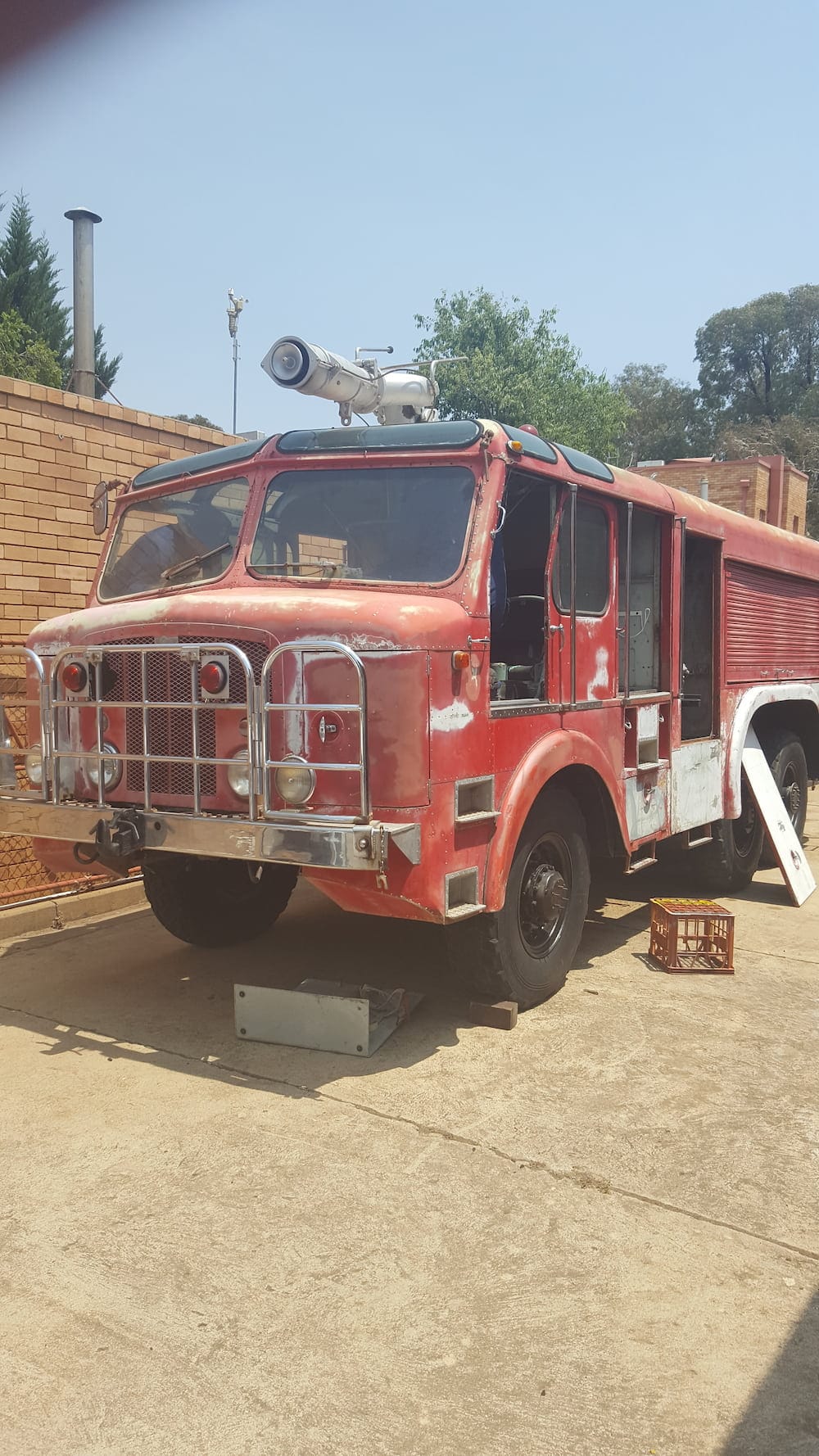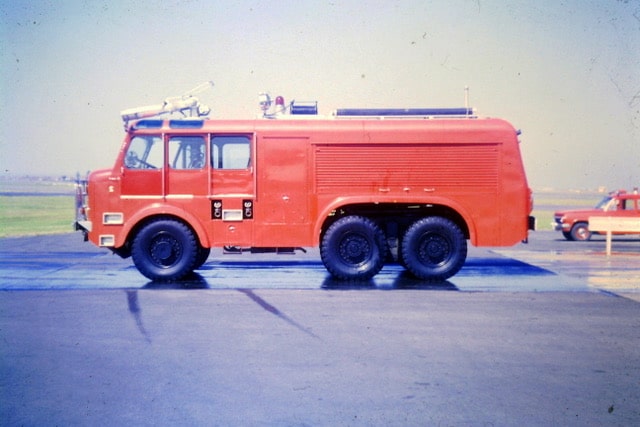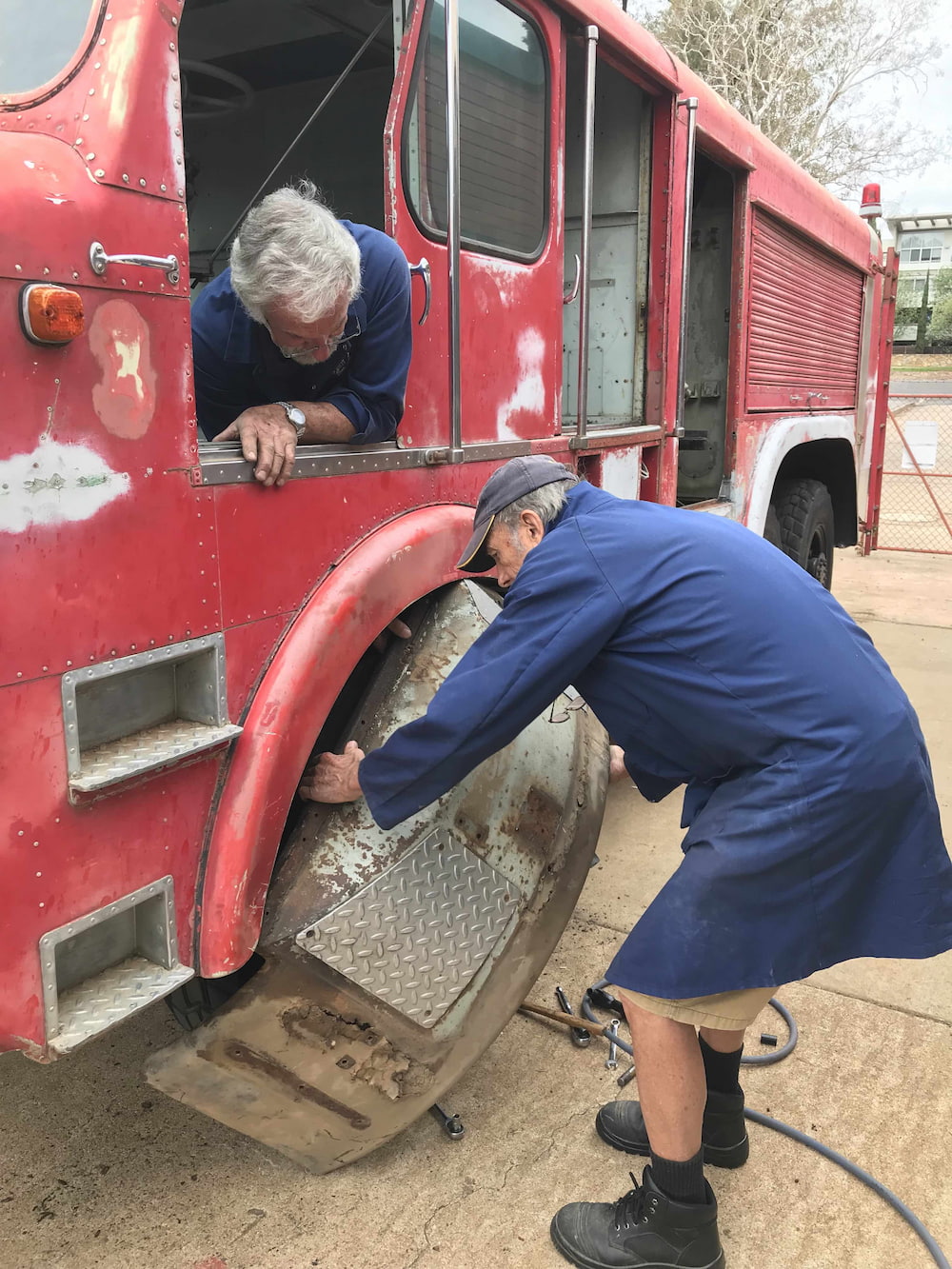The Thornycroft fire tender stands under a tarpaulin in the yard of the Canberra Fire Brigade Museum, Forrest, awaiting restoration.
Built in the 1960s, it operated at the Canberra airport until the mid-1990s. It is the only preserved historic vehicle known to have served at the airport from that time intended for public display, and the only 1960s aviation firefighting appliance in the museum’s collection.
Now, it will be repainted in its original red – “resprayed and restored to its original colour,” says volunteer guide Ian McCleary – thanks to an ACT Heritage Grant last year. (The 2022 round has just opened.)

“We’re in the business of trying to restore history, and keep the history of the fire services going,” Mr McCleary said.
“It’s very nice that the Heritage Council recognised that it’s something of value to Canberra history… It would be a terrible thing to lose that history.”
This is the second 1963 Mark III Thornycroft Nubian 6 x 6 large fire tender to have served at the airport. The Commonwealth Government bought the first for the airport in 1963; it crashed and rolled in the 1970s.
The replacement vehicle – one of a fleet of Commonwealth Department of Civil Aviation appliances that served NSW and the ACT from the 1960s – was then permanently stationed at the airport from the mid-1970s until 1996. When it was retired, it was given to the Fire Brigade Historical Society (FBHS) of the ACT.
The Thornycroft was “very, very noisy – but a very capable vehicle at the time,” Mr McCleary said.
It is a 14-ton six-wheel drive, with a 6.6 litre Rolls Royce B81 petrol engine. Manned by a crew of five, it could pump 3,600 litres of water, and 18,000 litres of foam a minute.
“It could throw foam quite a distance, for three or four minutes,” Mr McCleary remembered, before it had to be backed up with a water truck. “Hopefully, in that time, you had any fire out.”
Those pumps came in handy in 1977, when a Boeing 747B Alitalia jet was forced to land in Canberra after it hit some birds. The engine caught fire, and the gearbox casing was burnt through. “Molten metal dripped from the engine as the fire was brought under control,” the Canberra Times reported. Fortunately, nobody was harmed.
Firemen used carbon-dioxide extinguishers to put out the blaze.
“It was too high for us to get to any of the engines or the doors,” Mr McCleary remembered. “Nothing of that size had ever landed in Canberra before.

“But thankfully, there weren’t too many exciting incidents. And that’s what you dream of: that you go work, and you come home, and there’s been nobody hurt.”
Operating the fire tender’s pumps was a complicated eight-step process. “It required quite a lot of skills maintenance just to keep your hand in, knowing which levers [to pull], and getting your sequences right,” he said.
One senior firefighter would spend 15 minutes every day running the truck out of the fire station and positioning it as though they were attacking a plane fire. If Mr McCleary was rostered on as a driver, he would sit in the truck and go through the motions of what levers to push in what sequence.

The Thornycroft Mark III and its “little brother”, the Mark I, were “seriously thirsty”, Mr McCleary reminisced. In 1978, “the days when petrol was cheap”, he drove the Mark I to Sydney; he filled up before he left, then had to stop for petrol again at Goulburn and Camden before he reached Sydney airport.
Restoration work began two years ago. “We’ve had a battle in finding parts for it,” Mr McCleary said. They had to go to England to find butterfly valves for the carburettor, and the braking system required some innovative searching. The inside has been repainted; now, he said: “It’s nice to have it to a point where we can get it painted.”
Normally, the FBHS repaints fire trucks at the museum, but the Thornycroft is too big to paint in the yard without impacting the local community, Mr McCleary said. It will go to a specialist in Fyshwick who can “handle painting something this size” in an enclosed environment.

Once the truck has been repainted, it will go on display. “It’d be very nice to see it back in its glory, and able to be shown somewhere,” he said.
But where it will be stored has yet to be resolved. It could be parked at a fire station, or someone might have a big shed the engine could be parked in.
“When you put the effort and energy into restoring them, you don’t like to see them fall apart again simply because you can’t get it under storage,” Mr McCleary said.
The Thornycroft is one of many treasures of the Canberra Fire Brigade Museum’s collection, housed in the former Forrest Fire Station, built in 1939. There are historic fire engines, some from the 1920s and 1930s; the call centre’s elaborate networks of fire alarms; and relics from the 2003 fires, including melted metal from the Phillip fire truck caught in the firestorm.
The Museum, in Empire Circuit, Forrest, is open every Saturday from 10am to 2pm.
The restoration of the Thornycroft has been made possible by the ACT Heritage Grants, which identify, conserve, and celebrate Canberra’s history and heritage, said Rebecca Vassarotti, ACT Minister for Heritage.
“Canberra might be a relatively young city, but everywhere you look, you can see our territory’s rich and diverse history,” she said.
“From Tidbinbilla’s history of distilling eucalyptus oil, to the trails trodden by First Nations people, to the Forrest Fire Station precinct, there are local stories at the doorsteps of every Canberran. These stories deserve to be told and celebrated.”
This year’s round will provide $350,850 for local community projects. Ms Vassarotti hopes to see applications that document and record the histories of Canberra’s women, First Nation, multicultural, disability, and LGBTQIA+ communities. Applications close on 29 April.



